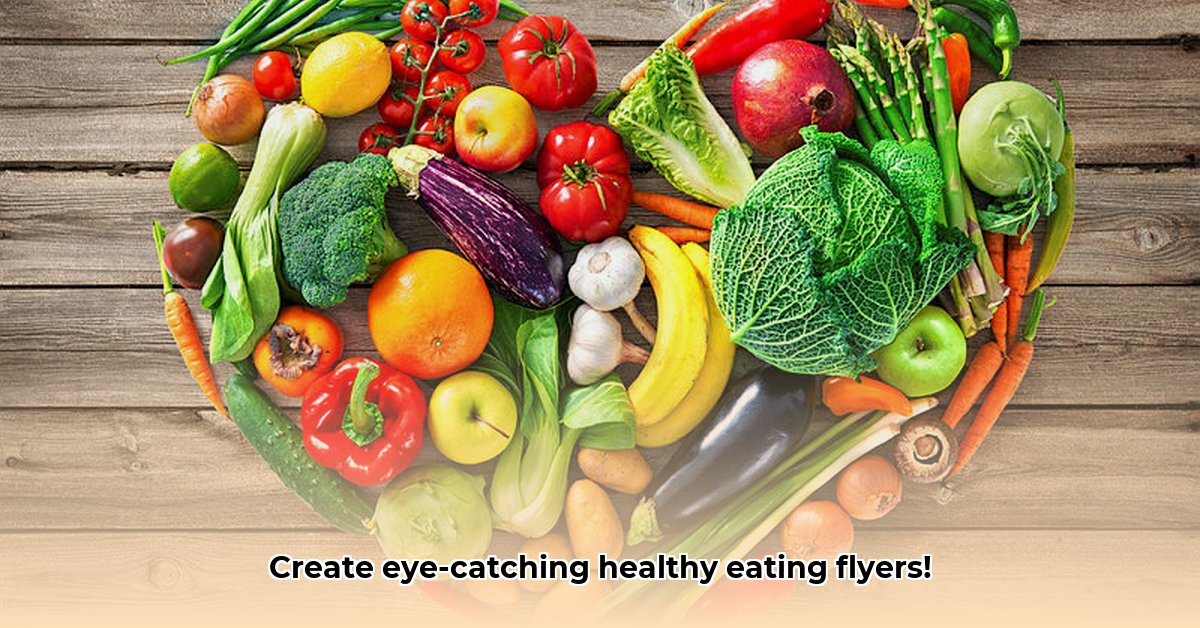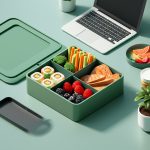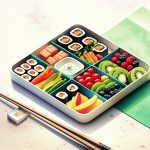Want to empower your community to embrace healthier lifestyles? Designing impactful healthy eating flyers is a great starting point. This comprehensive guide offers a detailed approach to crafting flyers that grab attention and deliver clear, motivating messages. Learn how to use visuals, language, and distribution strategies to inspire healthier choices and create lasting change. For more tips on establishing healthy eating habits, see this helpful resource.
Healthy Eating Flyers: A Guide to Designing Effective Public Health Materials
Creating truly effective healthy eating flyers goes beyond just slapping images and text onto a page. It’s about crafting a compelling message that motivates positive change. How do you design flyers that capture attention, provide valuable information, and inspire healthier choices? Let’s explore the key elements.
Designing Flyers That Pop: Visual Appeal and Clarity
Your flyer’s design is the first impression – ensure it counts. Does your flyer communicate the right message through its visual appeal?
1. Visuals Matter: Use fonts that are easy to read (Arial, Helvetica, or Calibri) and colors that are vibrant yet harmonious. For instance, use a color palette inspired by fresh fruits and vegetables. Instead of overwhelming statistics, choose high-quality photographs or illustrations that evoke positive emotions and resonate with your target audience. Ensure images are culturally relevant and representative of the community you’re trying to reach.
2. Layout: Guiding the Reader’s Eye: Organize information logically with clear headings, concise bullet points, and ample whitespace. A clean, uncluttered layout emphasizes core messages and prevents visual fatigue. Can readers quickly grasp the main points at a glance? Use a grid system to ensure visual consistency and balance.
3. Accessibility for Everyone: Use large, easy-to-read fonts (minimum 14pt) with good contrast between the text and background. Avoid using color combinations that may be difficult for people with color blindness to distinguish. Translate materials for diverse communities for broader reach and cultural relevance. Consider accessibility an essential aspect of your design from the outset. Provide alternative text for images for screen readers.
4. Learn from the Best (and the Worst): Research existing healthy eating materials from reputable organizations like the American Heart Association or the CDC. What design choices resonate with you? Analyze design successes and failures to improve your own work. Pay attention to how these organizations present information, use visuals, and tailor their message to different audiences.
Crafting Messages That Motivate: Language and Tone
Words can inspire or discourage. Which approach do you take with your flyer development?
1. Actionable Advice, Not Just Lectures: Instead of “Eat healthier,” suggest specific, realistic steps like “Swap soda for water” or “Add a serving of vegetables to dinner.” Clear, actionable instructions are more effective than vague advice. Provide practical tips that people can easily incorporate into their daily lives. Offer specific examples of healthy meals and snacks.
2. Positive Reinforcement, Not Guilt Trips: Focus on what people can do, rather than what they shouldn’t. Positive, empowering language fosters a sense of self-efficacy and encourages behavior change. Frame healthy eating as an opportunity to improve energy levels, mood, and overall well-being.
3. Cultural Sensitivity: Understanding Your Audience: Consider the cultural background of your target audience. What foods and values are important? Are there any dietary restrictions or preferences that you should be aware of? Researching cultural norms ensures your flyer is relevant, respectful, and more impactful. Collaborate with community leaders or members to ensure your message resonates with the target audience.
4. A Little Psychology Can Go a Long Way: Incorporate basic principles of behavioral change, such as goal setting, self-monitoring, and social support. A recent study showed that setting achievable goals increases success rates by 30%. Make healthy eating easier and more enjoyable to increase success. For example, suggest starting with small, manageable changes and gradually building up to larger ones. Provide resources for finding healthy recipes and connecting with others who are also trying to eat healthier.
Spreading the Word: Getting Your Flyers Seen
A beautifully designed flyer is useless if nobody sees it! Where would your target audience most likely see your flyers?
1. Knowing Your Audience, Knowing Your Place: Distribute flyers where your target audience spends time, such as community centers, schools, libraries, farmers’ markets, workplaces, and online platforms. Tailor the distribution to your specific audience. Partner with local organizations and businesses to expand your reach.
2. Strategic Placement: Maximum Visibility: Place flyers in high-traffic areas where people are likely to notice them. Consider using eye-catching displays or interactive elements to draw attention. Collaborations with local businesses can expand your reach and provide additional opportunities for distribution.
3. Measuring Your Success: Track engagement with your flyer and measure its impact. Use QR codes linking to surveys or online resources to gather feedback. Continuous improvement is vital, especially utilizing feedback surveys to understand what resonates with your audience and what could be improved.
Review of Sample Flyers (A Hypothetical Example)
What design and messaging choices could be improved using sample flyers (hypothetical)?
| Feature | Flyer A: Pros | Flyer A: Cons | Flyer B: Pros | Flyer B: Cons |
|---|---|---|---|---|
| Design | Clean layout, attractive images, easy-to-read font | Limited color palette; may not be visually striking | Vibrant colors, engaging imagery, clear hierarchy | Could be considered too busy for some viewers |
| Messaging | Actionable steps, positive tone | Could benefit from more culturally sensitive messaging | Culturally sensitive, uses inclusive language | May lack specific, actionable steps |
| Accessibility | Large font size, good color contrast | Not available in multiple languages | Available in multiple languages, easy navigation | Some images may require alt-text for screen readers |
Effectiveness depends on considering the target audience, crafting a compelling design and message, and choosing effective distribution channels. Regularly evaluate and refine your approach based on feedback and data.
How to Effectively Integrate Behavioral Change Techniques in Culturally Relevant Nutrition Education Programs
Nutrition education programs must be tailored to the unique needs and preferences of the communities they serve. How do you integrate behavioral change techniques effectively?
Key Takeaways:
- Culturally appropriate nutrition education is crucial in refugee communities.
- Community input is essential for effective participatory program design.
- Addressing language barriers and cultural competence are vital.
- Traditional foods and affordability are important factors.
- Effective evaluation methods track program impact.
Designing Effective Flyers: Visual Appeal Meets Cultural Sensitivity
Creating impactful healthy eating flyers demands understanding cultural nuances, with a flyer acting as a bridge to the target audience. What design considerations are required?
-
Visual Design: Choose readable fonts (translated into the native languages) and simple, culturally appropriate colors and imagery. A vibrant, welcoming design is crucial. Consult with community members on preferred colors and images.
-
Layout and Accessibility: Ensure clear information hierarchy using large fonts, high contrast, and multiple language options. Provide translations in all relevant languages.
-
Imagery: Photos should resonate with the community’s cultural background without stereotypes. Select authentic representations of diverse individuals and families enjoying healthy meals.
Crafting Compelling Messaging: Actionable Steps and Positive Reinforcement
Positive reinforcement is more effective than fear tactics; inspire lasting change by motivating techniques of behavioral change.
-
Clear and Concise Language: Short sentences with plain language for better understanding. Avoid using jargon or technical terms.
-
Culturally Sensitive Messaging: Tailor messages to cultural beliefs and practices, respecting food traditions. Incorporate traditional foods and recipes into your messaging.
-
Actionable Steps: Provide realistic steps with simple recipes and meal planning ideas. Offer practical tips on how to prepare healthy meals using locally available ingredients.
-
Behavioral Change Techniques: Use motivational interviewing techniques, goal setting, and social support strategies. Encourage participants to set realistic goals and track their progress. Provide opportunities for participants to share their experiences and support each other.
Choosing the Right Channels for Distribution: Reaching Your Audience
Where are target communities most active? The distribution location makes a big impact on the success of your flyers.
-
Community Centers and Schools: Partner with local organizations and schools for distribution. Offer workshops and cooking demonstrations at these locations.
-
Clinics and Healthcare Facilities: Distribute during appointments or health events. Train healthcare providers to promote healthy eating and distribute flyers.
-
Online Platforms: Use social media, community websites, and adapt designs appropriately. Create shareable content and engage with your audience online.
-
Evaluation: Track flyer distribution, engagement, and impact on healthy eating habits. Gather insights through surveys or focus groups. Use the data you collect to improve your program and tailor it to the specific needs of your community.
Review of Existing Resources: Learning from Best Practices
Analyzing successful and ineffective strategies helps refine your approach. What adjustments could be made for a more inclusive and effective flyer design?
Mastering Culturally Sensitive Messaging in Your Healthy Eating Flyers
Crafting flyers that truly connect with your community requires bridging complex health information with your audience’s lived experiences. What kind of messaging best fits your local population?
Designing Eye-Catching Flyers
First impressions are critical. How do you ensure your flyer grabs attention?
-
Visual Design: Use clear, bold lettering with thoughtfully chosen colors that evoke emotions and are culturally appropriate.
-
Layout: Create a clear path for information with headings, subheadings, and bullet points. Use whitespace effectively to avoid clutter.
-
Accessibility: Consider font size, contrast
- Mini Bento Boxes For Packing Kids Snacks And Small Meals - December 27, 2025
- Small Bento Box Makes Packing Lunch Easy and Fun Again - December 26, 2025
- Adult Bento Box Lunch Ideas For Quick Healthy Portable Options - December 25, 2025










